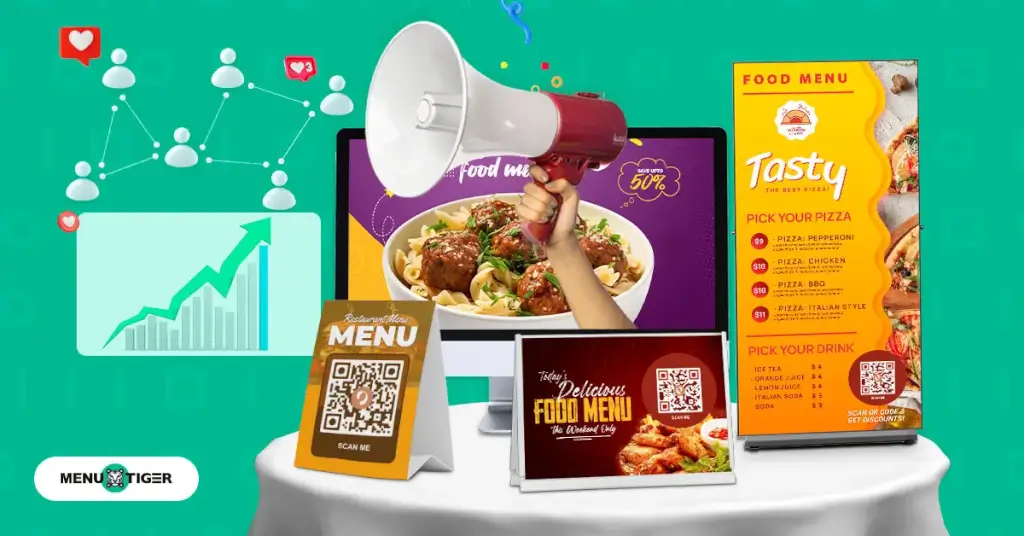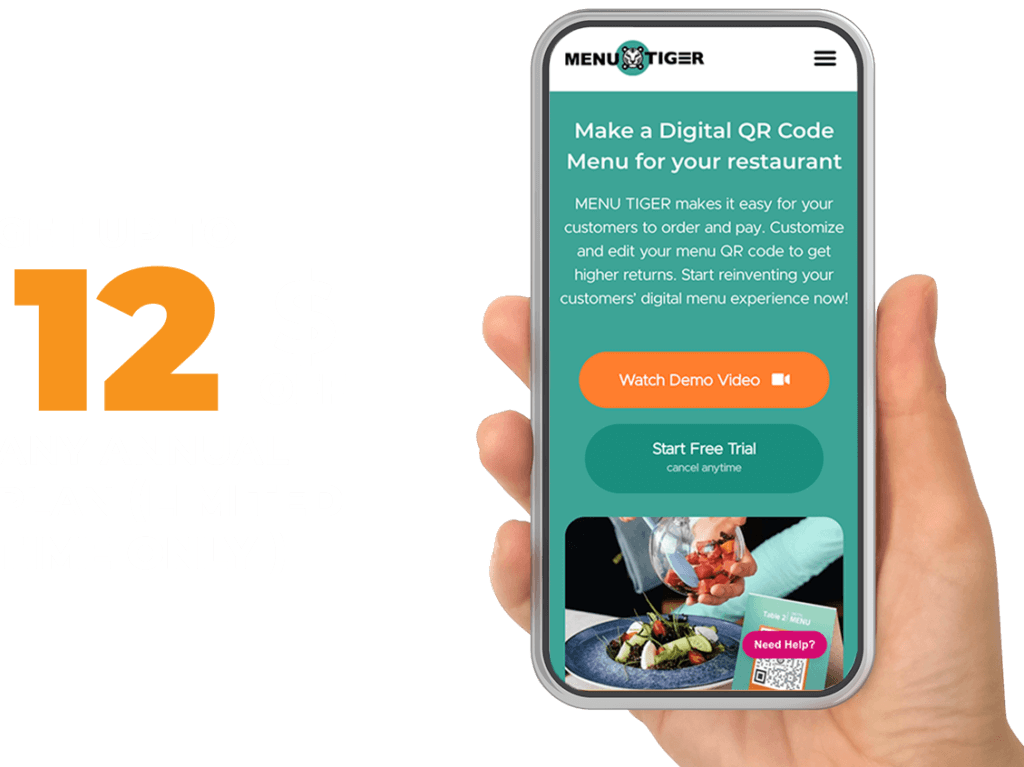Statista reported that in 2022, media spending on food advertisements in the United States on food, beverages, and sweets reached $7.5 billion, with restaurants accounting for another $9 billion.
In the same year, the spending of advertisement for food like preserved fruits, vegetables, and specialty foods also reached another billion.
Now, marketers or business owners won’t simply spend their bucks on a hopeless cause.
The huge total ad spending only suggests that the strategy is effective, whether on TV commercials, print ads, in-store displays, or other ad channels.
In this article, you’ll get bits and pieces of this marketing strategy, including alternative options like QR code menu technology, which you can use if you’re a starter or a seasoned restaurateur who wishes to seek a cost-efficient promotional platform.
Table of Contents
ToggleUnderstanding the role of food advertisements in the F&B industry
In 2020, UC Davis for Nutrition in Schools published an article that said food advertisements aim to reach a wide demographic through various sources and platforms.
Thus, it can easily sway the food choices of consumers.
In fact, according to the American Heart Association, 20,300 food and beverage companies have spent an estimated $13.5 billion on media advertising.
By doing so, businesses in the Food and Business industry are creating desire and demand for specific food or drinks by highlighting their taste, convenience, or health benefits.
These food ads serve as a platform for effective restaurant branding, and tools like Flipsnack can help to influence consumer behavior, shape brand perception, and drive sales, enabling businesses to establish themselves in the market.
15 successful food advertisements of all time across various channels
1. McDonald’s “I’m Lovin’ It” campaign (2003-present)
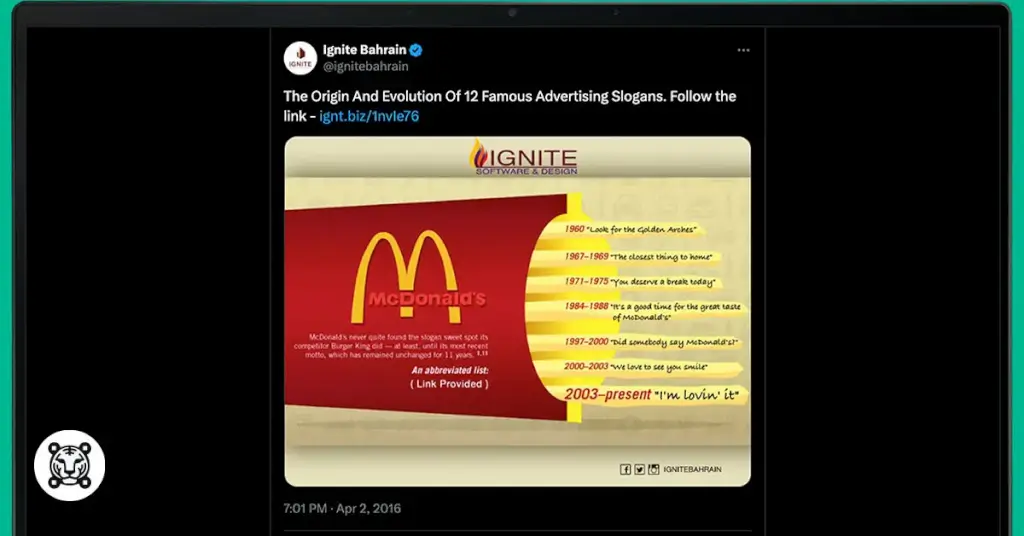
McDonald’s “I’m Lovin’ It” campaign is one of the most recognizable and successful ads for food of all time.
This ad’s concept features a catchy jingle and a variety of celebrities, which helped to keep the business at the top of the fast food industry.
As one of the most enduring fast food slogans, “I’m Lovin’ It” has become deeply ingrained in popular culture, reinforcing McDonald’s brand identity worldwide.
2. Skittles’ “Dippin’ Dots” (2017)

This ad features a group of friends sharing a bag of Skittles, and one friend suggests using them as sprinkles for Dippin’ Dots ice cream.
The ad was praised for its humor and creativity, and it helped to boost brand sales.
3. Wendy’s “Twitter Roasts” (2017-present)
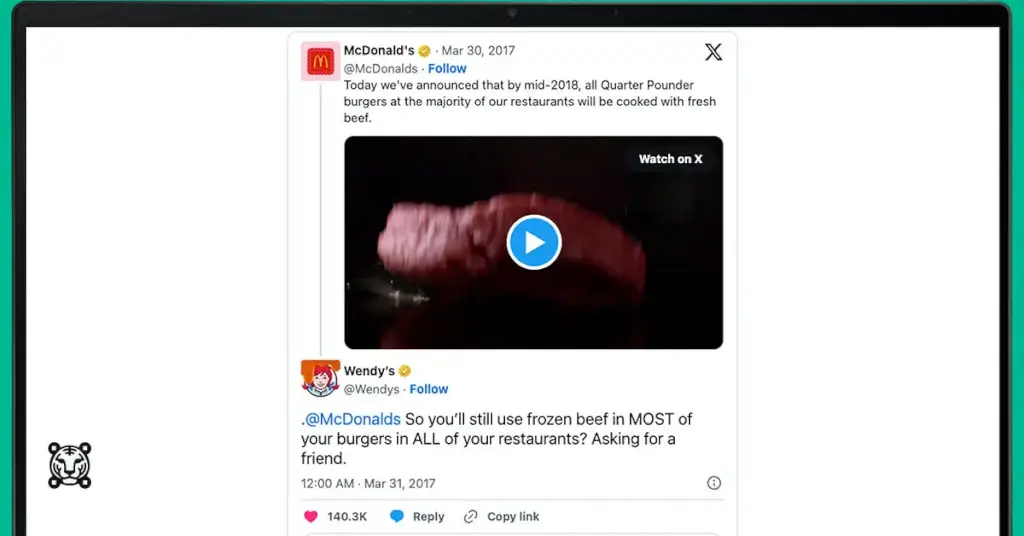
This fast-food restaurant is known for its sassy social media presence, and its “Twitter Roasts “ campaign is a perfect example.
The campaign features Wendy’s roasting its competitors on social media for restaurants like Twitter and has been incredibly successful in generating buzz and positive sentiment for the business.
4. Snickers’ “You’re Not When You’re Hungry” (2010-present)
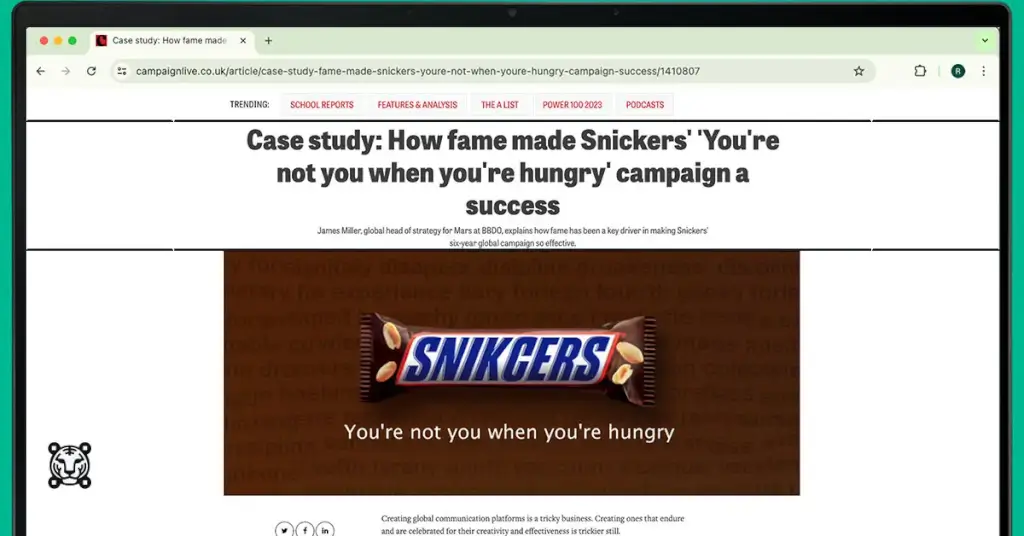
This long-running campaign continues to be effective, with new commercials featuring celebrities like Betty White and Willem Dafoe.
The ads play on the idea that people get angry when they’re hungry, and they always end up with one of the best food quotes and the tagline: “You’re not you when you’re hungry. Grab a Snickers.”
5. M&M’s “I Can’t Believe They’re Not Chocolate” (2017-present)
Celebrities like Maya Rudolph and Kristen Bell are joining this campaign to try to convince people that M&Ms are not actually chocolate.
The advertisement is funny and attention-grabbing, which captivates a lot of consumers.
6. Popeyes’ “Chicken Sandwich Wars” (2019)
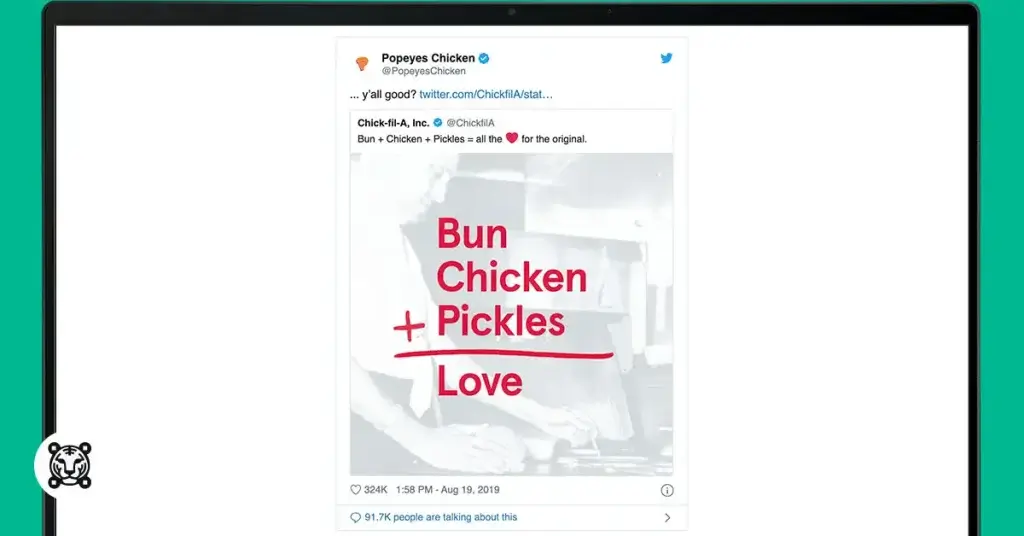
In 2019, Popeyes launched a new chicken sandwich that quickly went viral.
The sandwich was so popular that it led to a shortage of stocks at their branches across the country.
The “Chicken Sandwich Wars” helped to put Popeyes back on the map and showed the power of social media in driving trends.
7. Taco Bell’s “Nacho Fries” (2017-present)
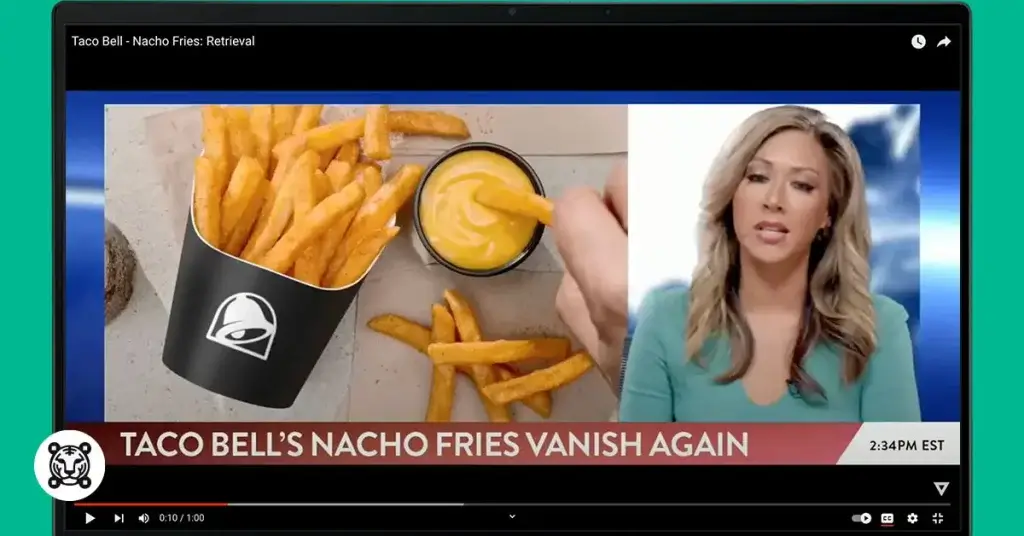
Taco Bell’s Nacho Fries have been a huge hit with customers, and the chain has capitalized on their popularity with a number of successful ad campaigns.
The ads typically feature people going to extreme lengths to get their hands on the menu, making it a must-try recommendation from Taco Bell fans.
8. Ben & Jerry’s “We Put the ‘Chill’ in ‘Chill Out” (2019)
This brand leverages its playful personality with a billboard that uses a temperature gauge as a visual.
The gauge needle points all the way to “Chill,” with a pint of Ben & Jerry’s ice cream below it. This simple yet effective billboard uses a relatable message and visual to promote Ben & Jerry’s ice cream as the perfect way to relax.
9. Chobani’s “Flip the Script” (2022)
Highlighting the versatility of yogurt beyond just breakfast, Chobani’s magazine spread showcased both savory breakfast bowls and decadent dessert parfaits.
The ad incorporated the tagline “Flip the Script. Flip the Routine,” encouraging consumers to embrace yogurt in new ways throughout the day.
10. Blue Diamond Almonds’ “Unexpected Pairings” (2021)
This magazine ad campaign went beyond the usual recipe suggestions.
It featured unexpected yet delicious food pairings that incorporated Blue Diamond Almonds, like dark chocolate and almonds or cheese, and a fruit plate with a sprinkle of almonds on top for added texture and flavor.
The campaign challenged viewers to get creative in the kitchen and explore new flavor combinations.
11. HelloFresh’s “Meal Time, Made Easy” (2020)
With a focus on convenience, HelloFresh adopted a minimalist approach in its magazine ad.
The campaign features a photo of a beautifully plated dish alongside the tagline, captivating busy consumers seeking convenient and delicious meal options.
12. Burger King’s “Grill Lines” (2022)
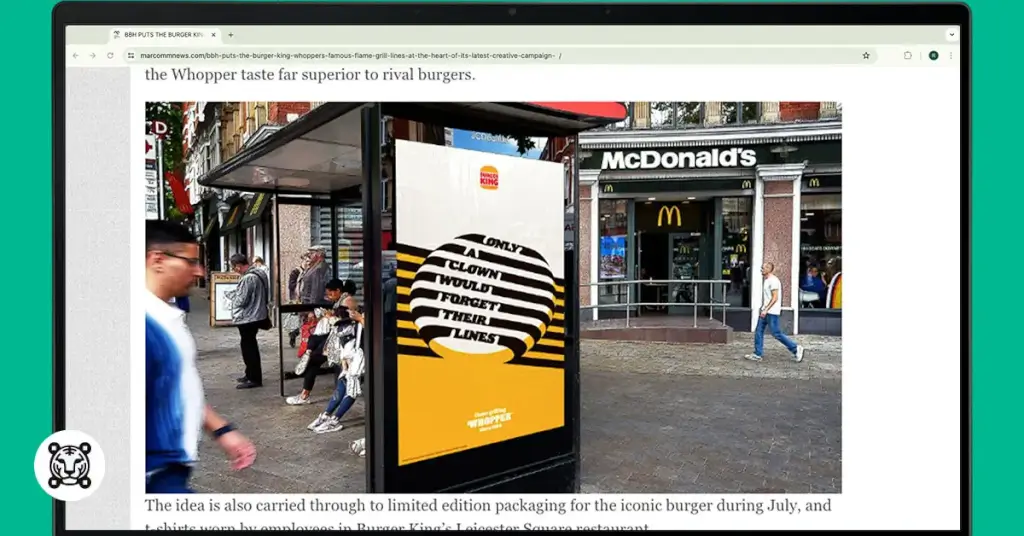
BBH, a marketing agency that has worked with Burger King since 2017, is giving the famous flame-grill lines on every Burger King Whopper patty limelight in their new campaign.
This idea is brought to life through outdoor and press advertising, where burger patties are imprinted with a simple seven-line pattern of grill lines. With a word in every line, each uses seven words to subtly remind viewers that Whopper’s unique flavor sets it apart from competitors’ burgers.
13. Domino’s “Blazing Pizza Slice” (2023)
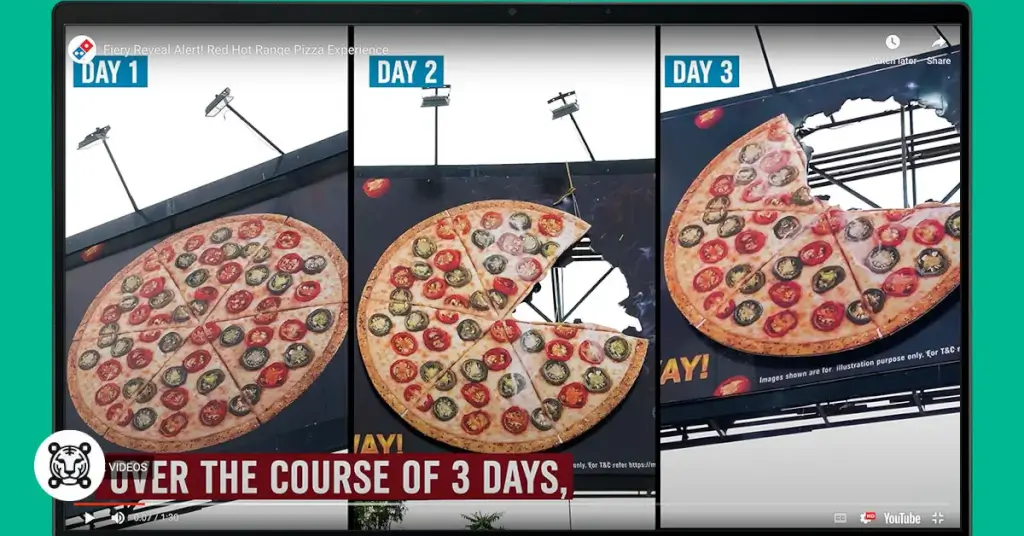
Domino’s Pizza took their new hot range pizza menu campaign seriously.
This billboard features a fiery on-ground activation event, which provides a sensory feast of fiery displays, smoky ambiances, and unparalleled excitement of spice.
This makes it captivating and sets the audience hooked.
14. Starbucks’ “Fuel Your Day. Dream Big” (2024)
This billboard features a steaming cup of Starbucks coffee next to a beautiful sunrise.
This ad uses a calming and aspirational image to associate Starbucks coffee with starting the day off right and pursuing one’s dreams.
15. Häagen-Dazs’ “That’s Dazs” (2024)
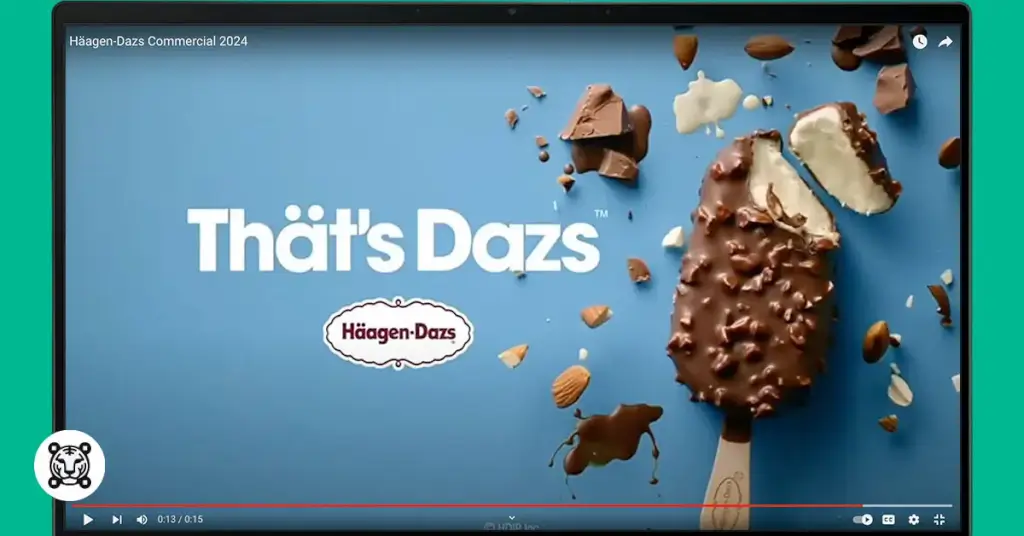
This latest commercial emphasizes the brand’s luxurious and indulgent nature.
This commercial, which can be viewed on platforms like YouTube, features the theme “Your Heart Knows What It Wants” and showcases the Chocolate Cookie Crumble Bar.
The ad aims to evoke a sense of sophisticated enjoyment, appealing to those who seek premium ice cream experience in their daily lives.
7 different types of food advertisements
If you’re still venturing into the know-how of advertising food in general, you might want to start with this list of common ad platforms:
Television commercials and advertisements for food
Television commercials are one of the most traditional and widespread forms of food advertising, heavily leveraged by advertising agencies to reach mass audiences.
These ads are broadcast during scheduled breaks in television programming, reaching a broad audience base.
Advertisers usually use a combination of visuals, sound, and narrative to capture the viewer’s attention. The goal is to stimulate their appetites and influence their purchasing decisions.
Despite the rise of digital media, TV commercials remain a powerful tool due to their broad reach and ability to create a strong emotional connection with their target market.
Print ads
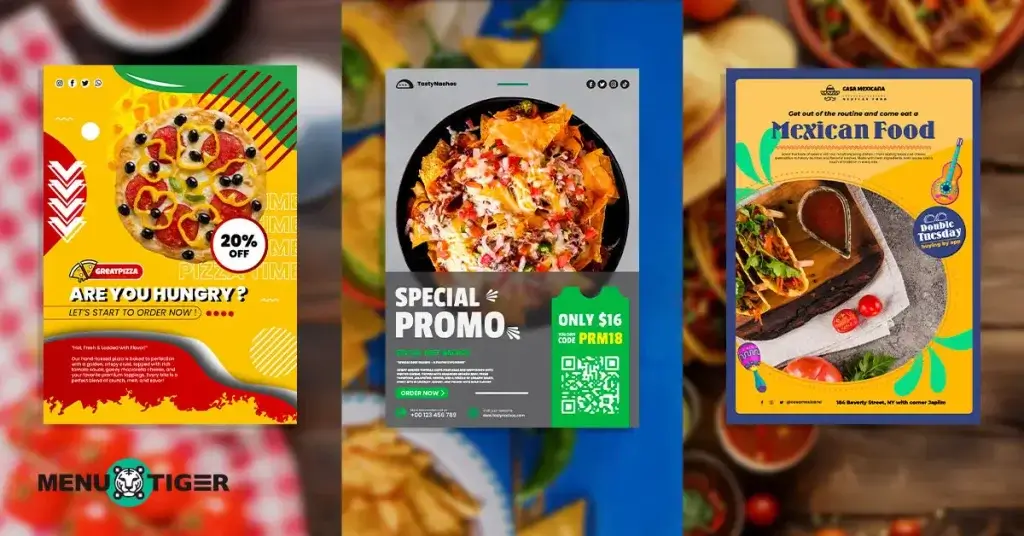
These advertisements rely on high-quality images and compelling text to attract readers.
Print ads can target specific demographics based on the publication’s audience, such as food magazines appealing to culinary enthusiasts or local newspapers targeting community members.
These ads can be highly informative and offer detailed descriptions of your products, recipes, and special promotions.
Digital ads
Digital food ads are pervasive across the internet, appearing on websites, apps, and streaming services.
These include banners, pop-ups, video ads, and sponsored content.
Digital advertising, as one of the restaurant marketing tools, allows precise targeting based on user data, such as browsing history, demographics, and interests. This enables advertisers to reach their ideal customers more effectively.
In-store displays
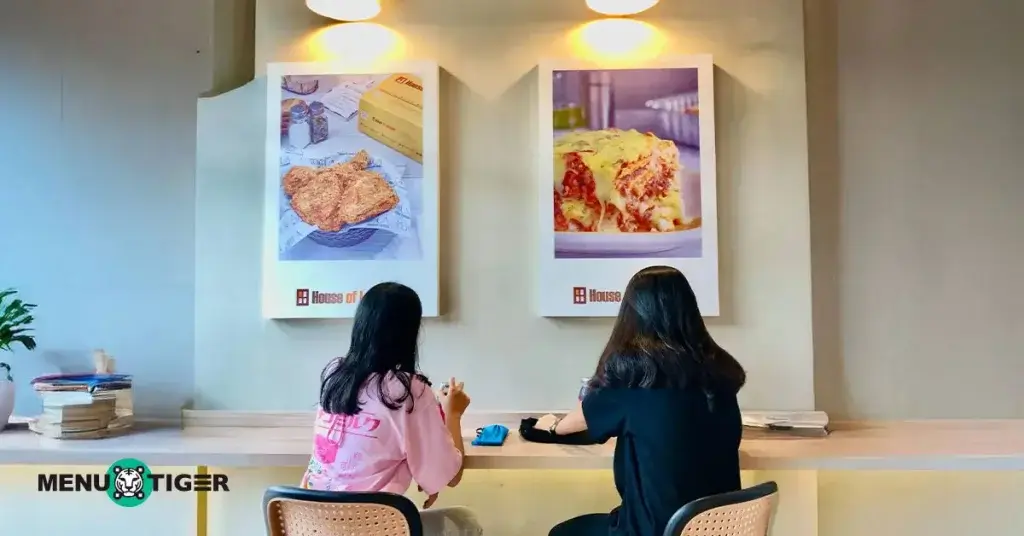
These are strategically placed food marketing materials found usually within retail environments.
These include shelf talkers, end-cap displays, and floor graphics designed to attract shoppers’ attention and influence their purchasing decisions at the point of sale.
In-store displays leverage the immediate proximity to the product, encouraging impulse buys and reinforcing brand presence.
Effective displays use vibrant colors, attractive imagery, and promotional offers to stand out.
Outdoor advertising
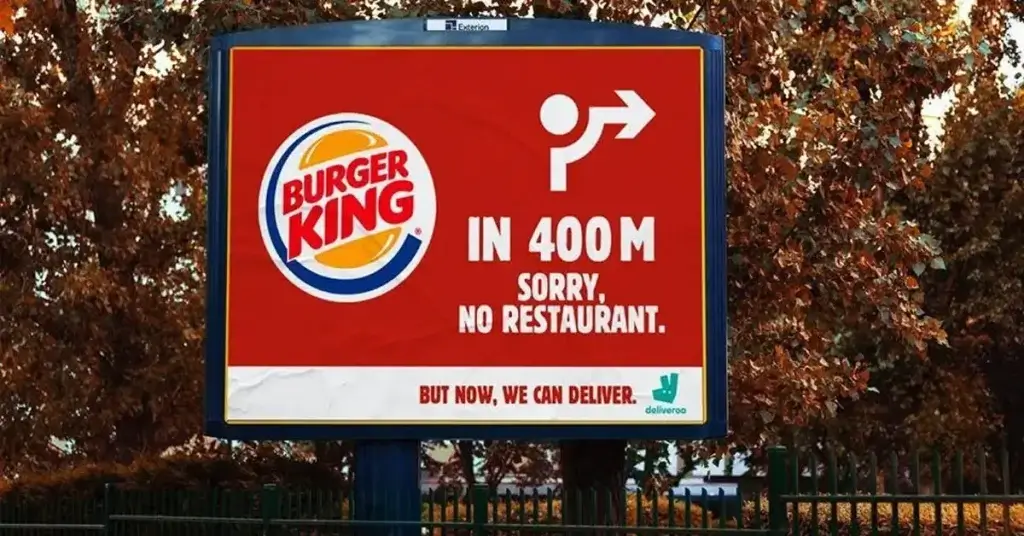
The key to successful outdoor advertising is creating bold, eye-catching designs that can be easily understood at a glance.
Food advertisements in this category often feature images of the products, memorable slogans, and clear restaurant branding strategies.
This includes billboards, bus shelters, transit ads, and other large-format displays located in public spaces.
This is particularly effective if placed in high-traffic areas, ensuring maximum brand recall and visibility.
These ads are designed to reach a wide audience, capturing the attention of people as they commute or go about their daily activities.
Social media campaigns
Social networks like Facebook, Instagram, Twitter, and TikTok are among the most effective campaign channels for businesses.
In fact, it has been indicated in the restaurant social media statistics that 50% of diners claimed that social media has influenced their restaurant choices.
These campaigns can include sponsored posts, influencer partnerships, and interactive content like polls, contests, and live videos.
The visual nature of these platforms is especially suited to food promotions, where it can drive consumer interest and shareability.
Event sponsorships and sampling
Event sponsorships and sampling involve promoting food products at events such as festivals, sports games, and trade shows.
Brands sponsor these events in exchange for advertising opportunities, such as signage, booth space, and the chance to distribute samples.
Sampling is a powerful marketing tactic, allowing consumers to try the product firsthand, which can lead to immediate purchases and long-term brand loyalty.
These events also provided a platform for brands to engage with consumers directly, answering questions, building a personal connection, and successfully employing their food commercials.

List of effective food advertising strategies

Sensory-rich descriptive language
Don’t just tell viewers your dishes are delicious; paint a picture with your words.
Use evocative language that vividly describes the taste, aroma, and texture of your offerings.
Mention the sweet and tangy burst of berries in a yogurt parfait, the smoky richness of a slow-cooked barbecue brisket, or the satisfying melt-in-you-your-mouth texture of chocolate fondue.
Stimulate their appetites and make them yearn to experience those flavors firsthand.
Targeted audience segmentation
Go beyond the demographics.
What this means is for you to dig deep with market research to understand your ideal customer’s lifestyle, values, and food motivations.
Are they health-conscious, busy professionals seeking premade meals for convenience? Or are adventurous foodies drawn to exotic ingredients and unique flavor profiles?
With this information, you can build laser-focused marketing efforts that target your specific customer persona.
Emotional connection through narrative
Food is more than sustenance; it is tied to a collection of memories, celebrations, and cultural traditions.
Craft a narrative that leverages these emotional associations. Show families bonding over a homemade pizza or friends connecting over a gourmet cheese board.
Evoke feelings of happiness, comfort, or indulgence to build a deeper brand connection that goes beyond the product itself.
Compelling visual storytelling
Food is a visual medium.
So, you need to use high-quality photos and videos that show the product’s aesthetic appeal. But don’t just stop there—tell a story.
Capture through food photography and videography the sizzle of a perfectly seared steak, the satisfying crunch of a fresh salad, or the joy of a family sharing a meal,
Make viewers crave the experience.
Distinct brand identity development
You are brand is your personality.
Cultivate a consistent voice, personality, and set of values that resonate with your target audience and differentiate you from the competition.
Think of the direction you want to explore. Are you going for a playful and fun concept or a sophisticated and elegant theme?
This distinct identity should be reflected in all your marketing materials, from packaging to social media posts.
Benefit-driven communication
People buy benefits, not features.
Don’t just list the ingredients of every food item; you must highlight how your food product solves a problem or fulfills a desire.
Focus on your business’s unique selling proposition (USP) that sets your food apart and speaks directly to your target audience’s needs.
Strategic social media integration in your food advertisements
Today’s consumers live on social media.
Leverage this power by creating engaging content tailored to each platform—partner with relevant influencers who share your brand values and can introduce your product to a broader audience.
Use targeted advertising strategies to ensure your message reaches the right people at the right time.
Omnichannel marketing approach
Think beyond the walls of social media.
Integrate your marketing initiatives across various channels. You can develop a user-friendly website with enticing product descriptions and delicious recipes.
Partner with food bloggers and recipe websites for product placement opportunities.
To amplify the impact of these campaigns, you can also work with specialists like Create & Grow, who focus on strategic link building for restaurants and food brands, earning high-quality, contextual backlinks that strengthen your overall marketing and help more customers discover you across search and social platforms.
Consider in-store promotions and engaging packaging that grabs the attention of grocery shelves and creates a cohesive experience that reinforces your brand message across all touchpoints.
Transparency and authenticity
We’re in the age of information overload, in which consumers crave transparency and authenticity.
Showcase the real ingredients in your commercials and the preparation methods used in your food and encourage user-generated content that reflects real people enjoying your product.
This fosters a sense of trust and authenticity that interests modern customers.
Restaurant ordering software: A cost-efficient tool to promote your products
Advertising demands a huge budget to begin with.
If you’re new to the business scene or a veteran who wants to explore modern ways of promoting, you might opt for the most popular ones, such as TV commercials, billboards, and or print media, which could cost you a lot.
The best alternative to a cheaper yet high-quality option is to use smart QR code menu software like MENU TIGER.
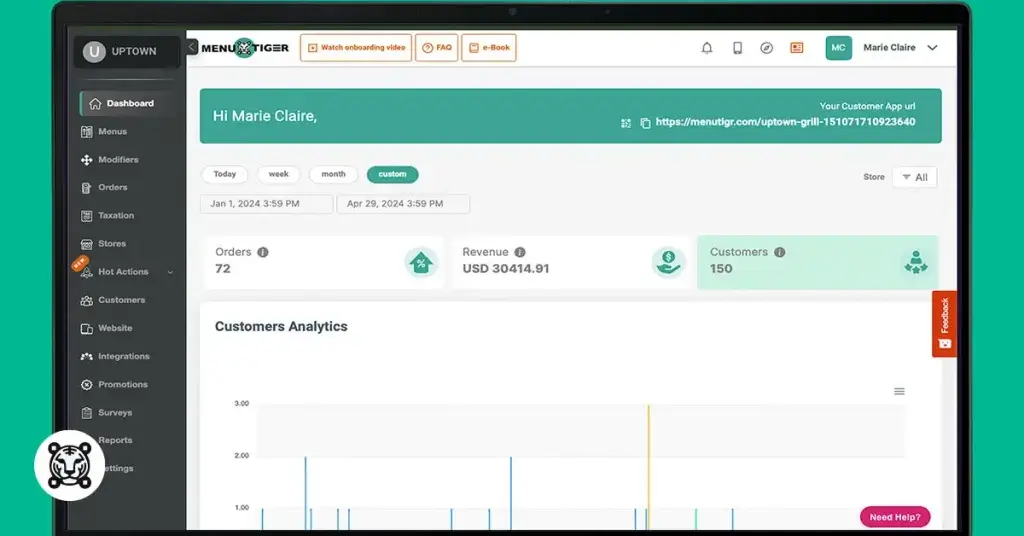
It streamlines your daily operations and provides a platform for promoting your offerings.
Here’s a list of the features and services you can use in your advertising:
Customizable restaurant website
Using this smart menu software, you can create your own website that contains all your information about offerings with high-quality visuals that will surely captivate consumers when they see them.
You can design the web page according to your branding.
Personal QR code menus for accessibility
This restaurant technology allows you to generate your QR codes for customers to access what more you offer, which you can incorporate into your social media posts and other marketing materials so that they can be accessed anywhere at any time.
Multilingual support on your digital menu
Reach a wider audience with this 15-language menu translation that can break language barriers among foreign customers.
This makes it easier for your target customer base to comprehend what you’re offering.

Make your audience crave and buy with QR code menu technology
Food advertisements are indeed effective tools for presenting items in the most creative way possible.
But we can’t deny that it will indeed cost you a big chunk of cash. That’s why having options like MENU TIGER QR code menu software can provide you with different ways to promote your products without burning a hole in your pocket.
The good thing about it is, it maintains the quality of promoting using a different method.
There’s actually more to this technology, so get your laptops, visit the website, and create an account for cost-efficient advertising stints.
FAQs
Advertising your food effectively involves a mix of strategies to reach and engage your target audience.
Here are some comprehensive steps to help you get started:
Identify your target audience
Create a brand identity
Develop a strong online presence
Leverage content marketing
Engage with influencers
Offer promotions and discounts
Participate in local events
Use paid advertising
Gather customer reviews
Focus on excellent customer service
Monitor and adjust your strategy.
An effective advertisement captivates the audience by appealing to both their senses and emotions. It often uses high-quality visuals that make the food look irresistible and evoke a sensory experience.
This typically highlights the unique aspects of food, such as freshness, taste, and quality ingredients, through engaging storytelling and clear, compelling messaging that resonates with the target audience.

